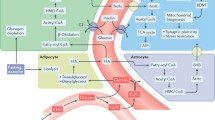Abstract
The regulation of the human energy metabolism is crucial to ensure the functionality of the entire organism. Deregulations may lead to severe pathologies such as diabetes mellitus and obesity. The decisive role of the brain as active controller and heavy consumer in the complex whole-body energy metabolism is the object of recent research. Latest studies suggest the priority of the brain energy supply in the competition between brain and body periphery for the available energy resources. In this paper, a systemic investigation of the human energy metabolism is presented which consists of a compartment model including periphery, blood, and brain as well as signaling paths via insulin, appetite, and ingestion. The presented dynamical system particularly contains the competition for energy between brain and body periphery. Characteristically, the hormone insulin is regarded as central feedback signal of the brain. The model realistically reproduces the qualitative behavior of the energy metabolism. Short-time observations demonstrate the physiological periodic food intake generating the typical oscillating blood glucose variations. Integration over the daily cycle yields a long-term model which shows a stable behavior in accordance with the homeostatic regulation of the energy metabolism on a long-time scale. Two types of abstract constitutive equations describing the interaction between compartments and signals are taken into consideration. These are nonlinear and linear representatives from the class of feasible relations. The robustness of the model against the choice of the representative relation is linked to evolutionary stability of existing organisms.











Similar content being viewed by others
References
Ackerman E (1964) A mathematical model of the glucose-tolerance test. Phys Med Biol 9:203–213
Barnsley M (1993) Fractals everywhere. Morgan Kaufmann, San Francisco
Bergman R, Phillips L, Cobelli C (1981) Physiologic evaluation of factors controlling glucose tolerance in man: measurement of insulin sensitivity and beta-cell glucose sensitivity from the response to intravenous glucose. J Clin Invest 68:1456–1467
Bobbert T, Wegewitz U, Brechtel L, Freudenberg M, Mai K, Moehlig M, Diederich S, Ristow M, Rochlitz H, Pfeiffer AFH, Spranger J (2007) Adiponectin oligomers in human serum during acute and chronic exercise: Relation to lipid metabolism and insulin sensitivity. Int J Sports Med 28:1–8
Clark D, Sokoloff L (1999) Basic neurochemistry: molecular, cellular and medical aspects. Lippincott Williams & Wilkins, Philadelphia
Conrad M, Hubold C, Fischer B, Peters A (2009) Modeling the hypothalamus–pituitary–adrenal system: homeostasis by interacting positive and negative feedback. J Biol Phys 35:149–162
Göbel B, Langemann D, Oltmanns K, Chung M (2010) Compact energy metabolism model: brain controlled energy supply. J Theor Biol 264:1214–1224
Guckenheimer J, Holmes P (2002) Nonlinear oscillations, dynamical systems and bifurcations of vector fields. Springer, New York
Hubbard JH, West BH (1995) Differential equations: a dynamical systems approach—higher-dimensional systems. Springer, New York
Jost J (2005) Dynamical systems. Examples of complex behaviour. Springer, Berlin
Kennedy G (1953) The role of depot fat in the hypothalamic control of food intake in the rat. Proc R Soc Lond B Biol Sci 140:578–592
Khalil HK (2002) Nonlinear systems. Prentice Hall, Upper Saddle River
Krieger M (1921) Über die Atrophie menschlicher Organe bei Inanition (German: about the atrophy of human organs under inanition). Z Angew Anat Konstitutionsl 7:87–134
Langemann D (2007) Selfish-brain theory: mathematical challenges in the top-down analysis of metabolic supply chains. In: Grundy J et al (eds) Proceedings of the tutorials, posters, panels and industrial contributions at the 26th International Conference on Conceptual Modeling—ER 2007 Auckland, New Zealand, CRPIT 83, ACS, pp 39–49
Langemann D, Peters A (2008) Deductive functional assignment of elements in appetite regulation. J Biol Phys 34:413–424
Langemann D, Pellerin L, Peters A (2008) Making sense of AMPA receptor trafficking by modeling molecular mechanisms of synaptic plasticity. Brain Res 1207:60–72
Maren S (1999) Long-term potentiation in the amygdala: a mechanism for emotional learning and memory. Trends Neurosci 22:561–567
Mayer J (1953) Glucostatic mechanism of regulation of food intake. N Engl J Med 249:13–16
Morton G, Cummings D, Baskin D, Barsh GS, Schwartz M (2006) Central nervous system control of food intake and body weight. Nature 443:289–295
Perko L (2001) Differential equations and dynamical systems. Springer, New York
Peters A, Langemann D (2009) Build-ups in the supply of the brain: on neuroenergetic cause of obesity and type 2 diabetes. Front Neuroenergetics 1(2):1–15
Peters A, Schweiger U, Pellerin L, Hubold C, Oltmanns K, Conrad M, Schultes B, Born J, Fehm H (2004) The selfish brain: competition for energy resources. Neurosci Biobehav Rev 28:143–180
Peters A, Pellerin L, Dallmann M, Oltmanns K, Schweiger U, Born J, Fehm H (2007) Causes of obesity—looking beyond the hypothalamus. Prog Neurobiol 81:134–143
Reilly T, Secher N, Snell P, Williams C (eds) (1990) Physiology of sports. E and FN Spon, London
Stanley S, Wynne K, McGowan B, Bloom S (2005) Hormonal regulation of food intake. Physiol Rev 85:1131–1158
Vatov L, Kizner Z, Ruppin E, Meilin S, Manor T, Mayevsky A (2006) Modeling brain energy metabolism and function: a multiparametric monitoring approach. Bull Math Biol 68:275–291
Walter W (1970) Differential and integral inequalities. Springer, Berlin
Zhang Y, Proenca R, Maffei N, Barone M, Leopold L, Friedman J (1994) Positional cloning of the mouse obese gene and its human homologue. Nature 372:425–432
Acknowledgments
The authors thank Dr. Matthias Conrad and Prof. Dr. med. Kerstin M. Oltmanns for their invaluable expertise in the development of the investigated models. This work was supported by the Graduate School for Computing in Medicine and Life Sciences funded by the German Research Foundation.
Author information
Authors and Affiliations
Corresponding author
Rights and permissions
About this article
Cite this article
Göbel, B., Langemann, D. Systemic investigation of a brain-centered model of the human energy metabolism. Theory Biosci. 130, 5–18 (2011). https://doi.org/10.1007/s12064-010-0105-9
Received:
Accepted:
Published:
Issue Date:
DOI: https://doi.org/10.1007/s12064-010-0105-9




